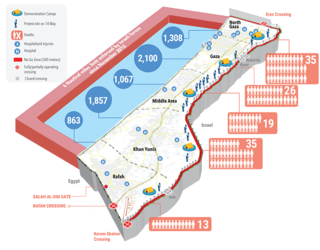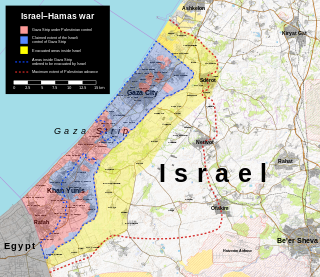Related Research Articles

The Gaza Strip smuggling tunnels are smuggling tunnels that had been dug under the Philadelphi Route along the Egypt–Gaza border. They were dug to subvert the blockade of the Gaza Strip to smuggle in fuel, food, weapons and other goods into the Gaza Strip. After the Egypt–Israel peace treaty of 1979, the town of Rafah, in the southern Gaza Strip, was split by this buffer zone. One part is located in the southern part of Gaza, and the smaller part of the town is in Egypt. After Israel withdrew from Gaza in 2005, the Philadelphi Corridor was placed under the control of the Palestine Authority until 2007, when Hamas seized power in 2007, and Egypt and Israel closed borders with the Gaza Strip.

The Israeli Combat Engineering Corps is the combat engineering forces of the Israel Defense Forces.

Adnan Al-Ghoul was the assistant of Mohammed Deif, the leader of the Izz ad-Din al-Qassam Brigades, the armed wing of Hamas. He was killed in a targeted killing along with Imad Abbas when an Israeli Air Force AH-64 helicopter attacked their car in Gaza on 21 October 2004. He is seen as a martyr by Hamas members.

The Izz ad-Din al-Qassam Brigades, named after Izz ad-Din al-Qassam, is the military wing of the Palestinian organization Hamas. Currently led by Mohammed Deif and his deputy, Marwan Issa, IQB is the largest and best-equipped militant group operating within Gaza today.

The 2006 Gaza–Israel conflict, known in Israel as Operation Summer Rains, was a series of battles between Palestinian militants and the Israel Defense Forces (IDF) during summer 2006, prompted by the capture of Israeli soldier Gilad Shalit by Palestinian militants on 25 June 2006. Large-scale conventional warfare occurred in the Gaza Strip, starting on 28 June 2006, which was the first major ground operation in the Gaza Strip since Israel's unilateral disengagement plan was implemented between August and September 2005.

The Gaza–Israel conflict is a localized part of the Israeli–Palestinian conflict originating at least from 1948 when 200,000 Palestinians fled or were expelled from their homes, settling in Gaza as refugees.

The Gaza War, also known as Operation Cast Lead, also known as the Gaza Massacre, and referred to as the Battle of al-Furqan by Hamas, was a three-week armed conflict between Gaza Strip Palestinian paramilitary groups and the Israel Defense Forces (IDF) that began on 27 December 2008 and ended on 18 January 2009 with a unilateral ceasefire. The conflict resulted in 1,166–1,417 Palestinian and 13 Israeli deaths.
Timeline of the Gaza War. For events pertaining to the conflict which occurred before 27 December 2009, see Gaza War (2008–2009)#Background and 2007–2008 Israel–Gaza conflict.

Al-Shifa Hospital is the largest medical complex and central hospital in the Gaza Strip, located in the neighborhood of northern Rimal in Gaza City. Originally a British Army barracks, the site was transformed into a healthcare facility, the Dar al-Shifa or "house of healing", by the government of Mandatory Palestine in 1946. The hospital was expanded during the Egyptian and later Israeli occupations during the 1980s. In the 21st-century, the hospital has been prominent during the Gaza–Israel conflict.

Kerem Shalom border crossing is a border crossing at the junction of two border sections: one between the Gaza Strip and Israel, and one between the Gaza Strip and Egypt. It is used by trucks carrying goods from Israel or Egypt to the Gaza Strip.

The 2014 Gaza War, also known as Operation Protective Edge, and Battle of the Withered Grain was a military operation launched by Israel on 8 July 2014 in the Gaza Strip, a Palestinian territory that has been governed by Hamas since 2007. Following the kidnapping and murder of three Israeli teenagers in the West Bank by Hamas-affiliated Palestinian militants, the Israel Defense Forces (IDF) initiated Operation Brother's Keeper, in which some 350 Palestinians, including nearly all of the active Hamas militants in the West Bank, were arrested. Hamas subsequently fired a greater number of rockets into Israel from the Gaza Strip, triggering a seven-week-long conflict between the two sides. It was one of the deadliest outbreaks of open conflict between Israel and the Palestinians in decades. The combination of Palestinian rocket attacks and Israeli airstrikes resulted in over two thousand deaths, the vast majority of which were Gazan Palestinians. This includes a total of 6 Israeli civilians who were killed as a result of the conflict.

A vast network of tunnels used for smuggling and warfare purposes exists under the Gaza Strip. The underground tunnel network allows Hamas and other militant groups to store and shield weapons, gather and move underground, communicate, train, launch offensive attacks, transport hostages, and retreat without being detected by Israeli or Egyptian authorities. This network of tunnels is colloquially referred to as the Gaza metro.

Subterranean warfare or underground warfare is warfare conducted underneath the ground surface. It is predominantly conducted in tunnels and underground cavities, both natural and artificial.

The 2018–2019 Gaza border protests, also known as the Great March of Return, were a series of demonstrations held each Friday in the Gaza Strip near the Gaza-Israel border from 30 March 2018 until 27 December 2019, in which Israeli forces killed a total of 223 Palestinians. The demonstrators demanded that the Palestinian refugees must be allowed to return to lands they were displaced from in what is now Israel. They protested against Israel's land, air and sea blockade of the Gaza Strip and the United States recognition of Jerusalem as capital of Israel.

On the evening of 27 October 2023, Israel launched a large-scale invasion of the Gaza Strip, as part of the 2023 Israel–Hamas war, with the stated goal of destroying Hamas and overthrowing the organization's governance of the Gaza Strip.
Abdel Aziz al-Rantisi Hospital is a children's hospital in the Nasser neighborhood of Gaza City. It is named after Abdel Aziz al-Rantisi, leader and co-founder of Hamas.
Israel has accused Hamas of using human shields in the Gaza Strip, saying that Hamas has purposely attempted to shield itself from Israeli attacks by storing weapons in civilian infrastructure, launching rockets from residential areas, and telling residents to ignore Israeli warnings to flee. Israel has also accused Hamas of maintaining command and control bunkers and tunnel infrastructure below hospitals. Hamas has denied using hospitals to shield any command center, while it has previously made remarks expressing support for Palestinians refusing to flee areas Israel has targeted.
During the 2023 Israel-Hamas war, Israel and the United States stated that a vast complex existed under the hospital that was being used by Hamas as its "main operations base", which Hamas and hospital administrators denied. Following Israel's release of video evidence on 22 November, multiple news agencies concluded that the evidence did not demonstrate the use by Hamas of a command center. The New York Times also said the evidence does not show conclusive evidence of a vast network of tunnels, while Haaretz concluded that Hamas did use the hospital for military purposes. Amnesty International said on 23 November 2023 that "Amnesty International has so far not seen any credible evidence to support Israel’s claim that al-Shifa is housing a military command centre" and that "the Israeli military has so far failed to provide credible evidence" for the allegation. Izzat al-Risheq, a Hamas official, denied that the group used the hospital as a shield for its underground military structures, saying there was no truth to the claims.

The 2023 Israel-Hamas war led to an intensive interrogation program by Israeli intelligence agencies, particularly Israel's domestic security agency, Shin Bet and IDF's Unit 504, targeting captured Hamas militants. Following the surprise Hamas attack on October 7, which resulted in approximately 1,200 Israeli casualties, mostly civilian, more than 600 militants were captured in Israel. Israel has claimed that the interrogation of the suspects revealed significant insights into the group's strategies, ideologies, and operational methods that played a crucial role in Israel's military response and in shaping the global understanding of the conflict.
References
- 1 2 3 Nicholls, Dominic (Oct 30, 2023). "'Sponge bombs': Israel's new secret weapon for inside Hamas tunnels". The Telegraph. Archived from the original on 2023-10-30. Retrieved Oct 30, 2023.
- ↑ Pradhan, Sucheta (Oct 28, 2023). "Sponge Bomb: IDF's New Way To Fight Subterranean Threats" . Retrieved Oct 30, 2023.
- ↑ "Israel's Innovative Solution In War Against Hamas: 'Sponge Bombs' To Seal Off Gaps In Gaza Tunnels. Explained". menafn.com. Retrieved Oct 30, 2023.
- 1 2 Trevithick, Joseph (Oct 27, 2023). "Does Israel Really Have 'Sponge Bombs' For Sealing Tunnels?". The Drive. Retrieved Oct 30, 2023.
- ↑ "What Are Israel's New Secret Weapon "Sponge Bombs" And How They Work?". NDTV.com. Retrieved Oct 30, 2023.